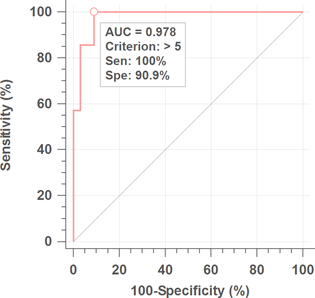台灣風險分析學會
Taiwan Society for Risk Analysis

2020年第20期
運用 1024 切拉曼光譜串聯演算法對醃漬蔬菜表面苯甲酸殘留進行食品安全風險分級
國立台灣大學生態工程研究中心副研究員 吳敏華、減塑聯盟研究員 林鼎彥
Release: Oct 05, 2020
苯甲酸(Benzoic acid, BA)是合法的食品防腐劑,可延長醃漬蔬菜 的保鮮期,但在台灣市場上,可能使得 2 歲以下的男性及 66 歲以上的女 性有較高的風險(Ling et al., 2015),也曾在其他國家出現偽過敏反應 (Pseudoallergy) (McCann et al., 2007)或增加兒童的過動症(Piper and Piper, 2017)。本研究新創串聯三種技術:超音波萃取、表面增強拉曼散 射(SERS)光譜、自適應迭代加權懲罰最小二乘法(Adaptive iteratively reweighted penalized least squares, AirPLS)演算法,對 40 個市售醃 漬蔬菜中的苯甲酸殘留多寡,進行風險分級。風險分級結果將與高效液 相層析法(High performance liquid chromatography, HPLC)進行比較和 相關分析。
利用 HPLC 進行 40 個醃漬蔬菜中的苯甲酸濃度分布是 0-820 ppm, 同時收集每一種醃漬蔬菜表面殘留物的 1024 切表面增強拉曼光譜 (Surface-enhanced Raman scattering, SERS)數值。透過先前的苯甲酸 標準品標定,本研究發現,苯甲酸在醃漬蔬菜表面有兩種結合型態:第 一種是單體、第二種是二聚體,苯甲酸單體的 SERS 數值落在波峰 944- 1005 cm-1(環烷結構)和 1366-1373 cm-1(羧酸結構)兩處,苯甲酸二聚體 在 1025 cm-1(對位環烷結構)和 1465-1482 cm-1(羧酸-氫鍵-羧酸結構), 將 1024 切光譜中的前述四段波峰區的最高數值,分別進行 Z-Score 轉換後,再各自對除(單體環烷結構除以單體羧酸結構;二聚體環烷結構除以 二聚體羧酸結構)轉換成為 Z-ratio BA 單體和 Z-ratio BA 二聚體。隨後,將 Z-ratio BA 單體+Z-ratio BA 二聚體的總和數值定義為「醃漬蔬菜中 苯甲酸的風險分級數值」,醃漬蔬菜中苯甲酸的風險分級數值與苯甲酸 的 HPLC 濃度呈現正相關。透過信號接受特質曲線(Receiver Operating Characteristics curve, ROC curve)分析醃漬蔬菜中苯甲酸的風險分級 數值與苯甲酸的 HPLC 濃度的敏感度(Sensitivity)與特異度(Specificity) 分別為 100%與 90.9%,如圖一,當醃漬蔬菜中苯甲酸的風險分級數值大於 等於 5 分時,可初判為高風險樣品,反之,當醃漬蔬菜中苯甲酸的風險分 級數值小於 5 分時,可初判為低風險樣品。
台灣的「食品良好衛生規範準則」中規範食品業者應自主管制與 紀錄食品安全的相關管理,然而食品業者設置實驗室之設備、人員訓練 及檢驗標準、作業程序等,是否具備足夠設備、人員技術、品質管理、 作業程序及檢驗能力等,是實務上可能出現的問題(Liu et al., 2018)。 另外常規檢驗過程中所需時間和檢驗成本皆造成中小型食品業者成本壓 力(Pylypiw et al., 2000; Dong et al., 2006; Techakriengkrai and Surakarnkul, 2007),應適度開放快篩檢驗合法化以降低業者檢驗成本支 出。本研究認為,運用拉曼光譜對醃漬蔬菜中的苯甲酸進行監測,是篩 選檢測方案之一,尤其檢驗花費相對低廉且更為快速,適合用於每批次 原料的初步檢測,更提供主管機關在食安風險管理和溝通上新的選擇。

圖一、當醃漬蔬菜中苯甲酸的風險分級數值大於等於 5 分時,在拉曼光譜 下可判斷為高風險樣品,當醃漬蔬菜中苯甲酸的風險分級數值小於 5 分時, 可判斷為低風險樣品。
參考文獻
1. Ling, M.-P., Lien, K.-W., Wu, C.-H., Ni, S.-P., Huang, H.-Y., Hsieh, D.P.H., 2015. Dietary Exposure Estimates for the Food Preservatives Benzoic Acid and Sorbic Acid in the Total Diet in Taiwan. Journal of Agricultural and Food Chemistry 63, 2074-2082.
2. Liu, G., Lu, M., Huang, X., Li, T., Xu, D., 2018. Application of Gold-Nanoparticle Colorimetric Sensing to Rapid Food Safety Screening. Sensors (Basel) 18, 4166.,
3. McCann, D., Barrett, A., Cooper, A., Crumpler, D., Dalen, L., Grimshaw, K., Kitchin, E., Lok, K., Porteous, L., Prince, E., Sonuga-Barke, E., Warner, J.O., Stevenson, J., 2007. Food additives and hyperactive behaviour in 3-year-old and 8/9- year-old children in the community: a randomised, doubleblinded, placebo-controlled trial. The Lancet 370, 1560-1567.
4. Piper, J.D., Piper, P.W., 2017. Benzoate and Sorbate Salts: A Systematic Review of the Potential Hazards of These Invaluable Preservatives and the Expanding Spectrum of Clinical Uses for Sodium Benzoate. Comprehensive Reviews in Food Science and Food Safety 16, 868-880.
5. Pylypiw, H.M., Grether, M.T., 2000. Rapid high-performance liquid chromatography method for the analysis of sodium benzoate and potassium sorbate in foods. Journal of Chromatography A 883, 299-304.
6. Dong, C., Mei, Y., Chen, L., 2006. Simultaneous determination of sorbic and benzoic acids in food dressing by headspacesolid-phase microextraction and gas chromatography. Journal of Chromatography A 1117, 109-114.
7. Techakriengkrai, I., Surakarnkul, R., 2007. Analysis of benzoic acid and sorbic acid in Thai rice wines and distillates by solid-phase sorbent extraction and highperformance liquid chromatography. Journal of food composition and analysis 20, 220-225.